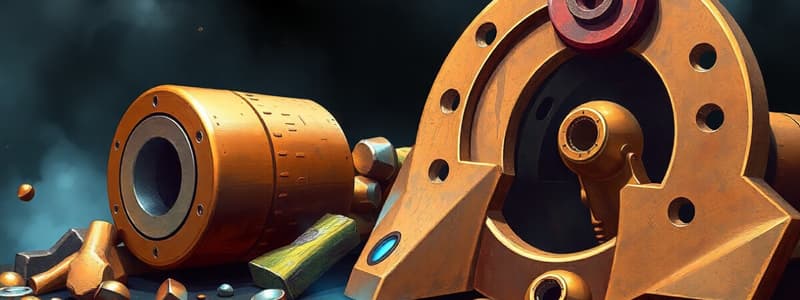Podcast
Questions and Answers
Which brass alloy is specifically mentioned as being suitable for hot work?
Which brass alloy is specifically mentioned as being suitable for hot work?
- Bell Metal
- Naval Brass
- Admiralty Brass (correct)
- German Silver or Nickel Silver
Which of the following alloys is known for its resistance to corrosion by seawater?
Which of the following alloys is known for its resistance to corrosion by seawater?
- Aluminium Bronze
- Naval Brass (correct)
- Bell Metal
- Gun Metal
Which of the following metals is NOT a component of Wood's Metal?
Which of the following metals is NOT a component of Wood's Metal?
- Lead
- Tin
- Zinc (correct)
- Cadmium
Which alloy is primarily used for decorative articles and utensils due to its silver-like appearance?
Which alloy is primarily used for decorative articles and utensils due to its silver-like appearance?
Which alloy is known for its golden color and is frequently used in casting operations?
Which alloy is known for its golden color and is frequently used in casting operations?
Which bronze alloy is particularly known for its resistance to the force of explosion?
Which bronze alloy is particularly known for its resistance to the force of explosion?
Which alloy is primarily used for bearings and springs due to its low coefficient of friction?
Which alloy is primarily used for bearings and springs due to its low coefficient of friction?
In solder, what happens to the melting point as the percentage of tin increases?
In solder, what happens to the melting point as the percentage of tin increases?
What is the primary purpose of Brazing Alloys?
What is the primary purpose of Brazing Alloys?
Which alloy is commonly used for marine castings and condenser tubes?
Which alloy is commonly used for marine castings and condenser tubes?
What is the approximate melting point of Wood's Metal?
What is the approximate melting point of Wood's Metal?
Which of the following alloys is NOT specifically mentioned as being used for marine applications?
Which of the following alloys is NOT specifically mentioned as being used for marine applications?
Which of the following is NOT a property of Duralumin?
Which of the following is NOT a property of Duralumin?
Which alloy is primarily recognized for its use in bells and gongs?
Which alloy is primarily recognized for its use in bells and gongs?
What is the main application of Tinmann's Solder?
What is the main application of Tinmann's Solder?
How does heat treatment affect the tensile strength of Duralumin?
How does heat treatment affect the tensile strength of Duralumin?
What is the carbon content range for medium carbon steel?
What is the carbon content range for medium carbon steel?
Which of the following alloys is NOT a type of brass?
Which of the following alloys is NOT a type of brass?
What is the approximate percentage of tin in Soft Solder?
What is the approximate percentage of tin in Soft Solder?
Which of the following is NOT a common application of Duralumin?
Which of the following is NOT a common application of Duralumin?
Which of these is a property of mild steel?
Which of these is a property of mild steel?
Which type of steel is best suited for making machine and gun parts due to its high tensile strength?
Which type of steel is best suited for making machine and gun parts due to its high tensile strength?
Which of the following is a characteristic of brass?
Which of the following is a characteristic of brass?
What is the primary use of cartridge brass (70% Cu, 30% Zn)?
What is the primary use of cartridge brass (70% Cu, 30% Zn)?
How does heat treatment affect the properties of brass?
How does heat treatment affect the properties of brass?
What is the primary difference between mild steel and medium carbon steel?
What is the primary difference between mild steel and medium carbon steel?
Which of the following metals is NOT a non-ferrous alloy?
Which of the following metals is NOT a non-ferrous alloy?
What is the primary application of high carbon steel?
What is the primary application of high carbon steel?
What type of solder is used for joining lead pipes?
What type of solder is used for joining lead pipes?
Which type of brass is known for its golden color and is suitable for all drawing and forming operations?
Which type of brass is known for its golden color and is suitable for all drawing and forming operations?
Flashcards
Mild Steel
Mild Steel
Steel with 0.05 - 0.3% carbon; good shock resistance, low tensile strength.
Medium Carbon Steel
Medium Carbon Steel
Steel with 0.3 - 0.6% carbon; tough, high tensile strength, weldable.
High Carbon Steel
High Carbon Steel
Steel with 0.6 - 1.5% carbon; hard, wear-resistant, can cut well.
Brass
Brass
Signup and view all the flashcards
Commercial Brass
Commercial Brass
Signup and view all the flashcards
Dutch Metal
Dutch Metal
Signup and view all the flashcards
Cartridge Brass
Cartridge Brass
Signup and view all the flashcards
Muntz Metal
Muntz Metal
Signup and view all the flashcards
Tensile Strength
Tensile Strength
Signup and view all the flashcards
Non-Ferrous Alloys
Non-Ferrous Alloys
Signup and view all the flashcards
Admiralty Brass
Admiralty Brass
Signup and view all the flashcards
Naval Brass
Naval Brass
Signup and view all the flashcards
German Silver
German Silver
Signup and view all the flashcards
Gun Metal
Gun Metal
Signup and view all the flashcards
Aluminium Bronze
Aluminium Bronze
Signup and view all the flashcards
Phosphor Bronze
Phosphor Bronze
Signup and view all the flashcards
Nickelbronze
Nickelbronze
Signup and view all the flashcards
Bell Metal
Bell Metal
Signup and view all the flashcards
Bronzes
Bronzes
Signup and view all the flashcards
Solders
Solders
Signup and view all the flashcards
Soft Solder
Soft Solder
Signup and view all the flashcards
Brazing Alloys
Brazing Alloys
Signup and view all the flashcards
Tinmann's Solder
Tinmann's Solder
Signup and view all the flashcards
Duralumin
Duralumin
Signup and view all the flashcards
Wood's Metal
Wood's Metal
Signup and view all the flashcards
Melting Point of Soft Solders
Melting Point of Soft Solders
Signup and view all the flashcards
Composition of Duralumin
Composition of Duralumin
Signup and view all the flashcards
Properties of Wood's Metal
Properties of Wood's Metal
Signup and view all the flashcards
Applications of Duralumin
Applications of Duralumin
Signup and view all the flashcards
Electrical Application of Wood's Metal
Electrical Application of Wood's Metal
Signup and view all the flashcards
Study Notes
Applied Science - Metals and Alloys
- Steel Types:
- Mild steel (low carbon) is easily weldable, has low tensile strength, and is resistant to shock and impact. Used in wires, chains, tubes, blades, and boiler plates.
- Medium carbon steel (0.3-0.6% carbon) is stronger and tougher than mild steel, can be hardened by heat treatment, and is resistant to shock; used in railway engineering (rails, wheels, axles), machine parts, and shafts.
- High carbon steel (0.6-1.5% carbon) is hard, tough, resistant to wear, creating sharp edges; used in tools, cutting instruments, and blades.
- Brass Alloys:
- Brasses are copper-zinc alloys.
- Varying percentages of zinc (up to 45%) and other metals (like tin, manganese, aluminum, iron, lead) give special properties.
- Strong, durable, machinable, corrosion resistant, and water resistant.
- Used in various applications (sheets, utensils, condenser tubes, architectural metalwork, jewelry, rivets, hardware).
- Copper Alloys:
- Pure copper is highly conductive, used in electrical transmission cables and appliances.
- Many alloys are used, mainly classified as Brasses and Bronzes.
- Bronzes:
- Bronze alloys are copper-tin alloys (with other possible added metals).
- They are tough, strong, corrosion-resistant, and machinable.
- Used in decorative items, utensils, cutlery, coinage, and tools (like gun barrels, hydraulic fittings, bearings).
Solders
- Types:
- Soft solders are low melting point alloys of tin and lead.
- The percentages of tin and lead affect the hardness.
- Brazing alloys are used for steel joints.
- Tinman's solder (66% tin, 34% lead) is used for joining tin articles.
- Uses:
- Used in electrical connections, tin cans, and for joining lead pipes.
Duralumin
- Composition: An aluminum alloy (95% aluminum, 4% copper, 0.5% magnesium, 0.5% manganese).
- Properties: Light, tough, ductile, corrosion resistant, easily castable.
- Applications: Aeronautics (aircraft parts), automotive components, and general engineering.
Wood's Metal
- Composition: A fusible alloy of bismuth, lead, tin, and cadmium.
- Properties: Low melting point (71°C).
- Applications: Safety plugs for pressure cookers, boilers, fire alarms, water sprinklers, taking impressions of coins or medals.
Studying That Suits You
Use AI to generate personalized quizzes and flashcards to suit your learning preferences.




